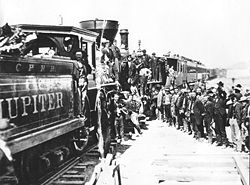
Back تاريخ النقل عبر السكك الحديدية في الولايات المتحدة Arabic Geschichte der Eisenbahn in Nordamerika German Histoire des chemins de fer américains French Az Amerikai Egyesült Államok vasúti közlekedésének története Hungarian Ferrovie nordamericane Italian アメリカ合衆国の鉄道史 Japanese Historia kolei w Stanach Zjednoczonych Polish USA:s järnvägshistoria Swedish การขนส่งทางรางในสหรัฐ Thai 美國鐵路運輸史 Chinese

Railroads played a large role in the development of the United States from the industrial revolution in the Northeast (1820s–1850s) to the settlement of the West (1850s–1890s). The American railroad mania began with the founding of the first passenger and freight line in the country, the Baltimore and Ohio Railroad, in 1827, and the "Laying of the First Stone" ceremonies and the beginning of its long construction heading westward over the obstacles of the Appalachian Mountains eastern chain in the next year. It flourished with continuous railway building projects for the next 45 years until the financial Panic of 1873, followed by a major economic depression, that bankrupted many companies and temporarily stymied and ended growth.
Railroads not only increased the speed of transport, they also dramatically lowered its cost. For example, the first transcontinental railroad resulted in passengers and freight being able to cross the country in a matter of days instead of months and at one tenth the cost of stagecoach or wagon transport. With economical transportation in the West (which had been referred to as the Great American Desert) now farming, ranching and mining could be done at a profit. As a result, railroads transformed the country, particularly the West (which had few navigable rivers).[1][2][3][4][5]
Although the antebellum South started early to build railways, it concentrated on short lines linking cotton regions to oceanic or river ports, and the absence of an interconnected network was a major handicap during the Civil War (1861–1865). The North and Midwest constructed networks that linked every city by 1860 before the war. In the heavily settled Midwestern Corn Belt, over 80 percent of farms were within 5 miles (8 km) of a railway, facilitating the shipment of grain, hogs, and cattle to national and international markets. A large number of short lines were built, but due to a fast developing financial system based on Wall Street and oriented to railway bonds, the majority were consolidated into 20 trunk lines by 1890. State and local governments often subsidized lines, but rarely owned them. Because of the economic importance and complexity of this new national system and failures in how they were run, the first federal regulatory agency, the Interstate Commerce Commission was created in the 1880s.
The system was largely built by 1910, but then trucks arrived to eat away the freight traffic, and automobiles (and later airplanes) to devour the passenger traffic. After 1940, the replacement of steam with diesel electric locomotives made for much more efficient operations that needed fewer workers on the road and in repair shops.
A series of bankruptcies and consolidations left the rail system in the hands of a few large operations by the 1980s. Almost all long-distance passenger traffic was shifted to Amtrak in 1971, a government-owned operation. Commuter rail service is provided near a few major cities, including New York City, Chicago, Boston, Philadelphia, Baltimore, and Washington, D.C. Computerization and improved equipment steadily reduced employment, which peaked at 2.1 million in 1920, falling to 1.2 million in 1950 and 215,000 in 2010. Route mileage peaked at 254,251 miles (409,177 km) in 1916 and fell to 139,679 miles (224,792 km) in 2011.[6]
Freight railroads continue to play an important role in the United States' economy, especially for moving imports and exports using containers, and for shipments of coal and, since 2010, of oil. Productivity rose 172% between 1981 and 2000, while rates rose 55% (after accounting for inflation). Rail's share of the American freight market rose to 43%, the highest for any rich country,[7] primarily due to external factors such as geography and higher use of goods like coal.[8][9][10][11] In recent years, railroads have gradually been losing intermodal traffic to trucking.[12]
- ^ "Building the Transcontinental Railroad". Digital History. University of Houston. 2021.
- ^ Athearn, Robert G. Rebel of the Rockies: A History of the Denver and Rio Grande Western Railroad, pp. 4-5, 16-25, Yale University Press, New Haven, Connecticut, 1962.
- ^ Beebe, Lucius and Clegg, Charles. Narrow Gauge in the Rockies, p. 31, Howell-North, Berkeley, California, 1958.
- ^ Davidson, James West, et al. American Nation: Independence Through 1914, p. 304, Prentice-Hall, Upper Saddle River, New Jersey, 2000. ISBN 0-13-434888-5.
- ^ Blum, John M. et al. The National Experience: A History of the United States, pp. 298-9, Harcourt, Brace & World, Inc., New York, New York, 1963.
- ^ Bureau of the Census, Historical Statistics of the United States: Colonial Times to 1970 (1976) table Q398; Statistical Abstract of the United States: 2012. Washington, DC: U.S. Government Printing Office, 2011; pp. 1064, 1068.
- ^ "High-speed railroading". The Economist. July 22, 2010. Retrieved December 10, 2011.
- ^ Increasing EU Rail Share: Insights From the US Rail Experience Archived September 2, 2006, at the Wayback Machine See Alternate Link 7
- ^ International Union of Railways "DIOMIS: Benchmarking Intermodal Rail Transport in the United States and Europe" Alternate Source for Dead Link
- ^ Freemark, Yonah. "Freight as Passenger Rail's Worst Enemy — Or Something Else?". The Transport Politic. Retrieved June 20, 2023.
- ^ Manuel Bastos Andrade Furtado, Francisco (Summer 2013). "U.S. and European Freight Railways: The Differences That Matter" (PDF). Journal of the Transportation Research Forum. 52 (2): 65–84. Retrieved July 25, 2023.
- ^ "Supply Chain News: Is Trucking Gaining Share over Rail in Long Haul Freight Moves?". Supply Chain Digest. February 22, 2022. Retrieved August 3, 2023.
© MMXXIII Rich X Search. We shall prevail. All rights reserved. Rich X Search